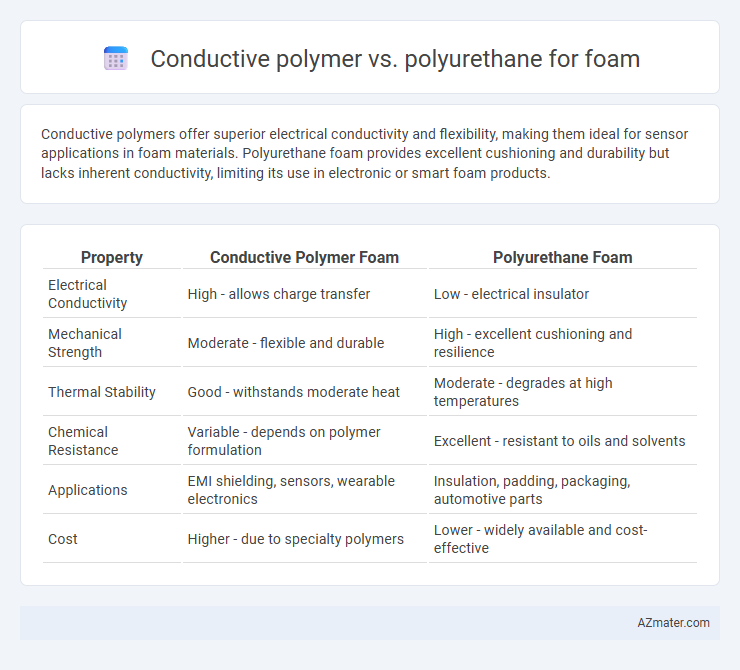Conductive polymers offer superior electrical conductivity and flexibility, making them ideal for sensor applications in foam materials. Polyurethane foam provides excellent cushioning and durability but lacks inherent conductivity, limiting its use in electronic or smart foam products.
Table of Comparison
| Property | Conductive Polymer Foam | Polyurethane Foam |
|---|---|---|
| Electrical Conductivity | High - allows charge transfer | Low - electrical insulator |
| Mechanical Strength | Moderate - flexible and durable | High - excellent cushioning and resilience |
| Thermal Stability | Good - withstands moderate heat | Moderate - degrades at high temperatures |
| Chemical Resistance | Variable - depends on polymer formulation | Excellent - resistant to oils and solvents |
| Applications | EMI shielding, sensors, wearable electronics | Insulation, padding, packaging, automotive parts |
| Cost | Higher - due to specialty polymers | Lower - widely available and cost-effective |
Introduction to Conductive Polymers and Polyurethane Foams
Conductive polymers exhibit unique electrical properties due to their conjugated molecular structures, making them ideal for applications requiring electrical conductivity combined with flexibility. Polyurethane foams, characterized by their lightweight, cushioning, and thermal insulation properties, are widely used in upholstery, automotive seating, and soundproofing. Comparing conductive polymers with polyurethane foams highlights the balance between conductivity and mechanical cushioning in advanced material design for electronics and comfort-focused industries.
Material Composition: Conductive Polymers vs Polyurethane
Conductive polymers consist of conjugated polymer chains with delocalized p-electrons, enabling electrical conductivity, whereas polyurethane is a segmented polymer made from polyols and isocyanates, primarily providing mechanical flexibility and durability without inherent conductivity. Conductive polymer foams incorporate dopants or fillers such as carbon nanotubes or graphene to enhance electrical pathways within the polymer matrix, while polyurethane foams rely on open or closed-cell structures for insulation and cushioning properties. Material composition differences directly impact electrical performance, with conductive polymers tailored for applications requiring charge transport and polyurethane optimized for structural support and resilience in foam products.
Electrical Properties Comparison
Conductive polymers feature intrinsic electrical conductivity achieved through conjugated polymer chains, making them suitable for applications requiring electromagnetic interference (EMI) shielding and static dissipation in foam materials. Polyurethane foams, however, are inherently insulating with low electrical conductivity but can be modified with conductive fillers such as carbon black or metal particles to enhance electrical properties. Compared to polyurethane foams, conductive polymer foams offer superior and more uniform electrical conductivity, enabling more efficient charge transport and long-term stability in electrostatic and sensing applications.
Mechanical Strength and Flexibility
Conductive polymers offer high electrical conductivity combined with moderate mechanical strength, making them suitable for applications requiring both conductivity and some flexibility. Polyurethane foam exhibits excellent mechanical strength and superior flexibility, providing resilience and cushioning in various environments. While conductive polymers excel in electronic functionality, polyurethane offers greater durability and deformation recovery essential for mechanical performance.
Thermal Stability and Insulation
Conductive polymers offer superior thermal stability compared to polyurethane foam, maintaining performance at higher temperatures without degradation. Polyurethane foam excels in thermal insulation due to its low thermal conductivity and cellular structure, effectively reducing heat transfer. While conductive polymers provide added electrical conductivity benefits, polyurethane remains the preferred choice for applications prioritizing thermal insulation and consistent thermal resistance.
Applications in Electronic Devices
Conductive polymers offer superior electrical conductivity and flexibility, making them ideal for applications like flexible electronic circuits and sensors. Polyurethane foam excels in cushioning and insulation properties, commonly used in electronic device packaging and protective layers. Combining conductive polymers with polyurethane foam enhances durability and conductivity in wearable electronics and flexible displays.
Advantages of Conductive Polymer Foams
Conductive polymer foams offer superior electrical conductivity compared to polyurethane foams, making them ideal for applications in sensors, electromagnetic interference (EMI) shielding, and wearable electronics. Their lightweight yet flexible structure enhances durability and comfort without compromising conductivity, unlike traditional polyurethane which lacks inherent electrical properties. Additionally, conductive polymer foams provide greater environmental stability and easier integration with electronic components, optimizing performance in advanced technological uses.
Benefits of Polyurethane Foams
Polyurethane foams offer superior cushioning and durability compared to conductive polymers, making them ideal for applications requiring long-lasting comfort and support. Their excellent thermal insulation properties and resistance to moisture enhance performance in furniture, automotive, and bedding industries. Polyurethane foams also provide cost-effective manufacturing with versatile density options tailored to specific mechanical and aesthetic needs.
Environmental Impact and Sustainability
Conductive polymers offer significant potential in reducing electronic waste due to their biodegradability and lower toxicity compared to conventional polyurethane foams, which are typically derived from non-renewable petroleum resources and are difficult to recycle. Polyurethane manufacturing involves hazardous chemicals and generates emissions contributing to air and water pollution, whereas certain conductive polymers can be synthesized using greener methods with less environmental footprint. The lifecycle of conductive polymer foams aligns better with sustainability goals through enhanced recyclability and reduced persistence in landfills, making them a more environmentally responsible choice for foam applications.
Future Trends in Foam Material Innovation
Conductive polymers are rapidly gaining traction in foam material innovation due to their unique ability to combine electrical conductivity with lightweight and flexible properties, enabling advancements in smart cushioning and wearable technology integration. Polyurethane continues to dominate foam applications with ongoing enhancements in sustainability, such as bio-based formulations and improved recyclability, supporting eco-friendly manufacturing trends. Future developments will likely emphasize hybrid composites that merge conductive polymers with polyurethanes, optimizing performance for responsive, durable, and multifunctional foam products.

Infographic: Conductive polymer vs Polyurethane for Foam
 azmater.com
azmater.com